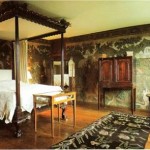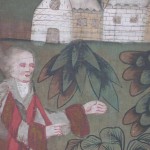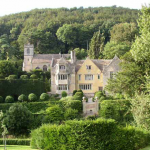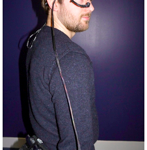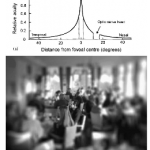Ways of Seeing the English Domestic Interior, 1500-1700: the case of decorative textiles
On 19th March I attended the third workshop for this AHRC research network. The aim of the day was to explore how eyetracking technology can be exploited towards the understanding of visitor experience of 17th century painted cloths at Owlpen Manor in Gloucestershire.
The day began with two groups of volunteers being “wired up” to the eyetracking hardware. The first thing to consider and why we can undertake this kind of experiment is that the eye does not work in the way we think it does. Eyes do not pan smoothly like in a film instead move in a series of small jerks. They actively only focus clearly on a very small area at the centre of the eye. The best way to think about it is that they essentially create lots of static images that focus on a small area. This means you are never too aware about exactly where you are looking and you can’t try and think too much about where your looking and don’t understand so the effect of wearing the headset is not to great.
The first of these groups was a group of undergraduate and masters students while the second comprised of *experts* from the research network. The intention was to explore the effects of expertise on the way people are viewing the interiors of the room and the effect of knowledge. Each person was individually wired up to the equipment and given time to get use to wearing it. Then they were taken to the Great Chamber (Queen Margaret’s Room) here their responses to the room were recorded a number of times. The first observation was recorded to observe the difference between the two groups of volunteers. Each individual was then provided with more information about the room and the wall painting and sent back into the room with the intention to observe which areas were focussed on in more detail or not.
Some preliminary results saw a huge difference in the way an expert was looking at the room as opposed to the student they were compared with. Students tended to move their gaze to try and take in everything whereas the expert took much more time paying close attention to the painted cloths.
The day then turned to a series of talks by people involved with the project, firstly with an outline of the project to date. This was followed by a talk on Owlpen Manor and specifically the Painted Cloths displayed in the Queen Margaret room which we observed during the eyetracking experiment. The painted cloths are thought to be the only complete example of a decorative scene of interior decoration of this form the scene details the biblical story of Joseph. They were a cheaper substitute for tapestries before the introduction of wall papers and were produced by guilds until around 1502 and were considered out dated by the 17th century. Although no longer in situ they represent a complete scene and only are missing the bottom border when in the 1960s they were moved from a different bedroom during a cleaning at the same time. This move has been questioned as to whether the move would have affected the story at all? Whether areas of the border would have an effect or whether they are placed into a different order or were designed for the original space. The talk also touched on whether the effect of the cloth on walling affected the experience of the space if they had been painted with the same scenes with some discussion on the acoustical effects on the space.
This led into a discussion of the direction the research network wishes to go in. In September 12th and 13th there will be a conference presenting the results of the research network. The papers from the conference are to be published in a Textiles journal, and we have considered whether they should be publishing more widely, considering the number of methods used. We discussed the achievements of the network so far. It was felt that with a range of specialities we have allowed an engagement with objects and spaces that has not been possible until now. This has highlighted that there are different kinds of viewing and the type of space or display affects the interaction with the objects or textiles. Particularly in reference to this was the assessment of the critical eye; we do not just look with our eyes but want to manipulate the objects in the space they are in or change the lighting conditions. In reference to this context it is very important to link the space and object when considering them in their historical context and how they were experience in the past. For example the lighting conditions at Owlpen Manor were very different and had a different effect on the viewers to examining objects at the Ashmolean. As such when we are considering the experience of an object we need to respond to how we think about the narrative associated with these objects or spaces.
Following the conference it was unanimous that the research network did not want to be downgraded but hoped it would continue in one way or another, maybe setting up a research project. The team was divided into two groups: heritage professionals and those in academia. We considered moving forward by into looking more at how the computer techniques that have been demonstrated could further the work. There was a bit of a struggle considering whether we could apply them appropriately, there is a lot of archaeological theory associated with how visualisation technology can be applied to explore these issues and whether this can inform the experience of those examining/ creating these items in the past. Whereas the heritage professionals wished to apply the technologies as a technique for reverse designing for museums and engagement impact in schools. They also wished to consider more how people are engaging with objects today and allowing greater access to collections and also whether these techniques can be used to track engagement with real vs. non real objects. The Shakespeare Birthplace staff suggested it would be interesting to examine audience perception of performance props costume etc.

